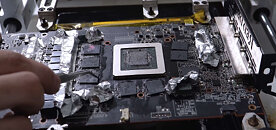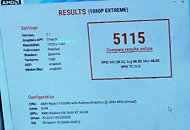- Joined
- Oct 9, 2007
- Messages
- 47,849 (7.39/day)
- Location
- Dublin, Ireland
| System Name | RBMK-1000 |
|---|---|
| Processor | AMD Ryzen 7 5700G |
| Motherboard | Gigabyte B550 AORUS Elite V2 |
| Cooling | DeepCool Gammax L240 V2 |
| Memory | 2x 16GB DDR4-3200 |
| Video Card(s) | Galax RTX 4070 Ti EX |
| Storage | Samsung 990 1TB |
| Display(s) | BenQ 1440p 60 Hz 27-inch |
| Case | Corsair Carbide 100R |
| Audio Device(s) | ASUS SupremeFX S1220A |
| Power Supply | Cooler Master MWE Gold 650W |
| Mouse | ASUS ROG Strix Impact |
| Keyboard | Gamdias Hermes E2 |
| Software | Windows 11 Pro |
The mid-range AMD Radeon RX 5600 XT is not supposed to have 16 GB of video memory, but the same hardware modders from Brazil behind the recent GeForce RTX 2080 16 GB mod, had other ideas for the card. They have not only increased the memory size to 16 GB through memory chip replacement, but also succeeded in widening its memory bus to 256-bit. The RX 5600 XT was launched in 2018 with 6 GB of 14 Gbps GDDR6 memory over a 192-bit memory interface. The card is cut down from the 7 nm "Navi 10" silicon powering the RX 5700 series, by enabling 36 out of 40 compute units (the same count as the RX 5700), but with a truncated 192-bit memory bus wired to 6 GB of memory (and so 25% lower memory bandwidth).
Paulo Gomes and Ronaldo Buassali pulled off the daring Radeon RX 5600 XT memory mod, which involves not just increasing the memory size from 6 GB to 16 GB, but also widening the memory bus from 192-bit to 256-bit. Since the RX 5600 XT is based on the same "Navi 10" GPU as the RX 5700, custom-design graphics cards tend to reuse PCB designs from the RX 5700 series, and have two vacant memory pads that are sometimes exposed and even balled. The mod involves three key stages—to replace the six 8 Gbit GDDR6 memory chips with eight 16 Gbit ones; to add the required electrical SMDs and VRM components for the two additional memory chips; and lastly, to give the card a modified BIOS that can let it play with the new memory configuration. The "Navi 10" silicon also powers certain Radeon Pro graphics cards with 16 GB of memory using 16 Gbit memory chips, so that could be the starting point for the BIOS mod.


The mod was successful, and the GPU was able to address 16 GB of memory, which means it is able to benefit from the wider memory bus. During the course of the BIOS mod, the team also gave GPU overclocking their best shot. The result of the memory mod and GPU overclock is a massive 29% performance gain when tested with Unigine Superposition. The resulting card is essentially a Radeon RX 5700 with 16 GB and a GPU, but its ingenuity is beyond impressive!
View at TechPowerUp Main Site | Source
Paulo Gomes and Ronaldo Buassali pulled off the daring Radeon RX 5600 XT memory mod, which involves not just increasing the memory size from 6 GB to 16 GB, but also widening the memory bus from 192-bit to 256-bit. Since the RX 5600 XT is based on the same "Navi 10" GPU as the RX 5700, custom-design graphics cards tend to reuse PCB designs from the RX 5700 series, and have two vacant memory pads that are sometimes exposed and even balled. The mod involves three key stages—to replace the six 8 Gbit GDDR6 memory chips with eight 16 Gbit ones; to add the required electrical SMDs and VRM components for the two additional memory chips; and lastly, to give the card a modified BIOS that can let it play with the new memory configuration. The "Navi 10" silicon also powers certain Radeon Pro graphics cards with 16 GB of memory using 16 Gbit memory chips, so that could be the starting point for the BIOS mod.


The mod was successful, and the GPU was able to address 16 GB of memory, which means it is able to benefit from the wider memory bus. During the course of the BIOS mod, the team also gave GPU overclocking their best shot. The result of the memory mod and GPU overclock is a massive 29% performance gain when tested with Unigine Superposition. The resulting card is essentially a Radeon RX 5700 with 16 GB and a GPU, but its ingenuity is beyond impressive!
View at TechPowerUp Main Site | Source






